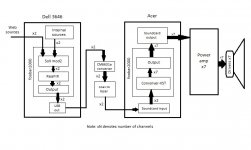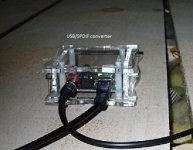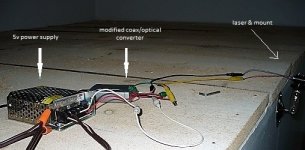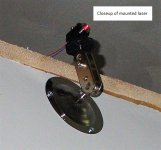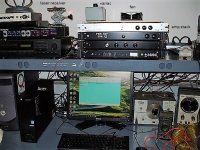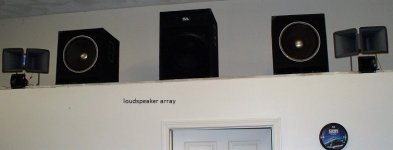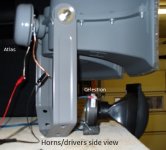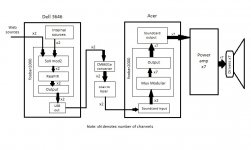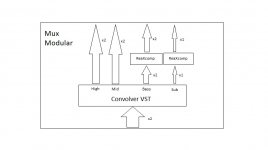I tend to have bias toward old-school, not without reasons. Since I cannibalized my parents' old Motorola TV for its electromagnet loudspeaker about 50 years ago (to make my little foldout record player sound better) I've been a hi-fi hobbyist in some sense. I acquired my first component system at college in 1969. It comprised a pair of AR-4x's, an HH Scott 222c amp and a Garrard turntable. In the 80s, having moved into a house with an accommodating and fairly large living room, I built my first 'dream' system. Speakers were, and still are, Altec 15" woofers in homemade tuned cabinets, Altec 511 horns with Peavey drivers and a variety of tweeters. Three heavy and overpowered (but quiet) stereo amps were fed by a 3-way 3rd-order Butterworth op-amp stereo crossover I built with the aid of the NSC Audio/Radio Handbook. The usual music sources were selected through a typical preamp and fed through a 10-band EQ. It still sounds good; sources have been modernized.
But for a long time I did nothing but occasionally repair the system. Then a couple of years ago I decided to use my large garage as a vehicle for a new hi-fi, and determined to do something good with relatively little expense. It has gone through a number of modifications over these few years and now comprises (I believe) the best approach for my purposes while retaining at least the old-school speaker philosophy. Good products and support from MiniDSP got me started with the digital approach and I had a series of DSP-based systems. Now that approach has been superseded.
I recently altered the form of my DSP-box-based system. Requirements remained good sound at good cost, but after much consideration I decided to add another requirement, that of making the system as software-centric as possible. Not long after making my desktop the primary source of music I realized I could replace the first of two chained Minisharcs (acting as a FIR-based equalizer) with software on my desktop. The experiment was effective, so I began to explore whether the second sharc/DAC (used as a FIR-based crossover with 8 outputs) could be as successfully replaced; that also proved doable and effective. Thus many components of the system are now pure software, facilitating experimentation as the development and target machines are identical. It could all have been done on one desktop, but I have opted to use two due to factors explained below.
In summary, the system currently comprises:
1. Source/preamp stage: a Dell SFF desktop houses music sourcing and front-end DSPs.
2. Link to crossover/poweramp stage: a CM6631a-based USB/spdif converter feeds a modified coax/toslink converter that powers and modulates a 5mw laser which illuminates one end of a fiber optic cable 40' away.
3. Crossover stage: another SFF desktop (Acer) armed with a CM8828-based 7.1 pcie sound card acts as a multi-driver stereo crossover/DAC. It accepts stereo spdif input from the laser and sends 7 channels of output to the power amps.
4. Power amp stage: several single-rackspace power amps, some using TDA7492 boards and some Sure AA-AB32971 boards, accept soundcard output.
5. Loudspeaker stage: an array of large, efficient loudspeakers (still my preference) accepts power amp output.
All are described below along with the software involved, working backwards from the end point (speakers) to the source desktop.
The loudspeakers are 3-way and flank a sub. They were chosen for efficiency, clarity, durability and affordability (less than $1500) and are as follow:
Subwoofer: a $240 Seismic SAP-18S is a downfiring 18" driver/cab with which I am quite pleased. It retains the 18" Seismic driver, but the integral passive crossover is bypassed. It crosses over to the woofers at 70hz 42db/oct. Besides providing deep lows, it unloads high-excursion frequencies from the woofers.
Woofer (each): a modified $150 Seismic 15" sub cabinet houses an Altec 421A bass driver. The resonant frequency of the cab is ~31hz, identical to that of the Altec. The cabinets required a bit of mounting hole widening with a drill-mounted drum sander and notching with a round file to front-mount the Altecs. An integral passive crossover in the cabinet is bypassed. The assembly crosses from the sub at 70hz 42db/oct. and to the midrange at 300hz 66db/oct. The 421As (or the very similar and more common 421-8H) are generally available used or reconed for ~$100 and are, IMO, among the best low-mid drivers ever made.
Midrange (each): an Atlas PD-5VH Alnico compression driver feeds an EV/University Cobreflex horn, functionally identical to the horn that once graced University systems like the 'Corner Dean'. The modern incarnation is of ABS rather than cast aluminum. It has a 250hz cutoff and loads the Atlas driver well. The Atlas is mentioned on Klipsch fora as a good mid replacement for the Klipschorn. Together they cost ~$300. The unit crosses from the woofer at 300hz 66db/oct., and to the tweeter at 2500hz 90db/oct.
Tweeter (each): An Eminence APT-200S biradial ABS horn loads a Celestion CDX1-1010 driver. They are a good match, the driver being loaded smoothly by the horn from ~1500hz to beyond audibility. The horn is mounted with its biradial flares horizontally opposed. It crosses from the mid at 2500hz 90db/oct. with a 45khz 30db/oct. rolloff. The cost of driver and horn together is ~$40.
Power amplification for the woofers and sub comes from three tiny stereo boards with TDA7492 and its class D support circuitry, ~$14 apiece. I have little information about them, but they seem to be based largely on basic prototype layouts shown in the chip manual. Though they are stereo boards only one channel is used, resulting in one board per woofer and one for the sub. The large and efficient speakers demand little power to overwhelm my 'room', a 47'x28'x12' garage. The amps are rated at 50w/ch (which they never approach) but my tests observed a board with one channel used throw more into an Altec test driver without scope-visible or audible distortion, something easy to hear at a test frequency of 150hz. The boards are mounted in industrial surplus 1u rack mount boxes (one for woofers, one for sub) each with its own regulated 24v switching power supply (about $30 apiece). The sub supply is housed in a separate rack box for historical reasons. The mid and high horn pairs are powered from one more box, a single supply driving two Sure AA-AB32971 'class T' stereo amp boards. These were used for the horns in hope that smoother output and improved phase behavior at higher frequencies might be obtained from a higher switching frequency. However the Sure boards have audible fans that go on and off constantly. The addition of a 5" AC box fan atop the case (run through a small variac at low speed) seems to provide enough quiet airflow to keep the onboard fans idle.
'Line level' tier processing is broken up a bit more. It has a source side and a crossover side, each housed in a separate desktop but doable in a single desktop if so desired. Note: I have tested both methods and heard no difference. Note: It is possible to eat CPU with certain DSP applications/settings and this becomes likelier using a single desktop, especially if it is not a dedicated audio machine.
We begin with the crossover side, still working our way from back to front. A $250 Acer Aspire SFF desktop (with mouse and keyboard, half that price if refurbished) got an old unused Dell monitor via a $20 hdmi/vga adapter. A usb wifi adapter was added as no wifi card came with the unit, but a $50 Bearextender was needed anyway for range. The other h/w augmentation was a 7.1 PCIe x1 sound card. This is worth discussing. Startech, Vantec, SIIG and others make what should be roughly equivalent cards, each ~$45. Each uses a CM8828 chipset. I have the Vantec and the Startech. The Acer came advertised (from the vendor) as having a single MiniPCIe slot but inspection happily revealed a single PCIe x16 slot. It also has two half-height expansion blanks on the rear panel. The Startech comes as two cards, one simply mounting the 4 stereo minijacks and connected to the processor card via supplied ribbon cable. The Vantec is a single card using a mini-DIN connector with minijack fanout. Both include optional half-height face plates permitting internal mounting on a SFF desktop. The driver is configured as 7.1 surround with 192k/24 (max) throughput to the onboard DACs. Additionally, each card comes with stereo Toslink 192k/24 (max) I/O ports. The input is used to feed an spdif signal to the machine. The Vantec is currently in use; both work fine.
A number of mostly freeware/donorware apps and plugins were downloaded once Windows 10 (preinstalled) was updated. The core app, foobar2000, was given plugins for external input (recording) and VST accommodation. The DSP loaded was Convolver-VST. This is the crux of multi-driver stereo crossover operation and is configured for 2 channels in, 192k sample rate, 4 partitions, 8 FIR processing channels and 7 channels out (subwoofer FIR channels are mixed to L+R mono). Each FIR is Linkwitz-Riley 32k-FFT (16k taps) 24-bit, generated by RePhase for 192k sample rate. The frequencies and slopes are mentioned in the speaker descriptions. RePhase permits mixing paragraphic EQ curves with the crossovers. This capability was used (e.g.) to ramp up midrange output past about 1.5khz to compensate for slight rolloff in the big Cobreflex horns. Convolver-VST's configuration file includes channel matrixing which, in my case, permits mixing LR sub channels to one mono output. It also provides wide programmable delay on each channel for phase alignment.
Across the garage, an existing Dell 3646 desktop was also fitted with foobar2000 and the accoutrements necessary for 192k/24 USB stereo output. Note again that I could simply stream music or rip cds directly onto the Acer and have it do all the work but wanted the ability to control source from my office. Thus a ~$35 box housing a CM6631a USB/spdif converter board was connected. Its output feeds a modified $15 coax-to-optical converter from which the toslink module was removed and a trimpot added to provide some DC offset to the output signal. The wall-wart power supply was replaced by a small $15 5V switching supply. The unit drives a $1 (!) 6mm/650nm laser module, embedded in a modified 12mm housing for easier mounting. The cmos inverter in the modified converter provides plenty of current to drive/modulate the laser. The receiving end of the data link can be an optical-to-optical device but I simply mount one end of an optical cable onto a small lab jack to adjust for slight vertical beam deviation with temperature/humidity. It feeds the laser signal to the soundcard's optical input. The laser has become another reason labor remains divided between the two desktops since I enjoy testing and improving it. Currently it has logged perhaps 1000 hours of operation without complaint.
Foobar2000 on the Dell has added DSPs also. A SoX/mod2 resampler plugin upsamples input to 192k and feeds a FIR equalizer. The EQ of choice (at the moment) is ReaFIR which offers up to 32k FFTs and adjusts automatically to sample rate, but its salient feature is real-time graphic adjustment capability. WASAPI or ASIO 24-bit output feeds the CM6631a's USB driver, to be sent via laser to the Acer. Music is sourced by streaming, downloads, ripped CDs or whatever common means. Both desktops have been given 8G memory upgrades at ~$50 each, which is totally optional.
Many details have been suppressed in the interest of readability, but here are some additional notes.
1. As mentioned briefly, my recent system used chained Minisharcs, one for equalization, the second (with stacked MiniDAC8) for crossovers/output. A separate MiniDSP 2x4HD fed my subwoofer. But despite their fine performance, low-frequency crossovers were difficult to implement due to tap limitations, cabling was becoming complex, sample rate was limited to 48k (96k on the 2x4HD) and the devices required laptop connection for modification. Hence my foray into desktop-as-DSP began. Much incremental hunting and testing was necessary but thankfully the results have simplified my tinkering. Flexibility (including tool choice) is greatly enhanced as might be expected. FIR size and sample rate capabilities are greatly increased. As I had difficulty finding any affordable DAC with more than 8 channel capability I was forced to temporarily pare down my former tweeter/supertweeter combo to a full tweeter. In so doing I found a happy permanent combination among unused on-hand equipment that has proven as good audibly as its predecessor with the added advantage of eliminating driver phasing at 9000hz (the old supertweeter xover point). Proof of concept was done using my laptop, abused as a test mule, and a surprisingly good CM6206-based 7.1 USB DAC for about $30 (limited to 48k/16). The much better than expected results inspired the current setup.
2. The PCIe soundcards have a claimed S/N spec of 92dB, not what audiophiles (nor I) care to see, but even though the card in use is mounted internally, noise is no problem and I'm glad I ignored the spec. I have a cable for external mounting but no reason to use it. The HDMI/VGA adapter causes some hum but only until the monitor blanks; hence, display timeout is set for one minute. A note for Windows 10 users: do not use supplied CDs for drivers nor download them from vendor sites or C-media. This will prevent a lot of pain trying to uninstall them when they prove difficult. Windows 10 has native support. Another note: surround is not pure DAC. Even with all effects disabled in the driver, I found that the 'rear channel' pipes a signal which is input to one channel to both outputs. This made the rear channel output a good candidate for my single subwoofer but nothing else. All other outputs, configured as 'full range', appear to act as pure stereo DACs with driver effects disabled. I'm not an HT guy so I don't know how much of this is standard 7.1 behavior.
3. As mentioned briefly, the fun of this setup is the ease of modification. New DSP plugins can be downloaded and installed and new filter curves generated and applied all on the actual target machines, hence a lot of tuning has been done and continues, not to mention a lot of free DSP auditioning. RePhase permits me to try any number of parametric combinations for my crossover filters; currently, Blackman-Nutall windowing and 32k FFTs (16k taps) seem to produce the most vivid output on the crossover side. The use of two SoX instances on the Dell (upsample for FIR processing followed by 192k downsample for output) can be tried. On the Acer, I keep a spare 96k crossover configuration and can change crossover sample rates fairly quickly. Note: there is an audible difference, for whatever reason.
4. Since Sox and ReaFIR permit the use of any sample rate, I have tried running my EQ FIR on the Dell side as high as 768k with fine results. However, this eats ~50% of CPU and, as the Dell is not a fully-dedicated audio machine, makes the use of other CPU-hungry programs difficult on the ears. Upsampling to 384k is no problem. I currently opt for the simple path to 192k, i.e. one SoX resampler preceding ReaFIR. I would love to feed higher sample rates to the Acer (the CM6631a and its driver will do 384k) if only to test the laser, but the soundcard is limited to 192k/24.
5. Some pictures and a diagram are attached. The Dell source desktop is omitted; it's not a very interesting photo subject.
But for a long time I did nothing but occasionally repair the system. Then a couple of years ago I decided to use my large garage as a vehicle for a new hi-fi, and determined to do something good with relatively little expense. It has gone through a number of modifications over these few years and now comprises (I believe) the best approach for my purposes while retaining at least the old-school speaker philosophy. Good products and support from MiniDSP got me started with the digital approach and I had a series of DSP-based systems. Now that approach has been superseded.
I recently altered the form of my DSP-box-based system. Requirements remained good sound at good cost, but after much consideration I decided to add another requirement, that of making the system as software-centric as possible. Not long after making my desktop the primary source of music I realized I could replace the first of two chained Minisharcs (acting as a FIR-based equalizer) with software on my desktop. The experiment was effective, so I began to explore whether the second sharc/DAC (used as a FIR-based crossover with 8 outputs) could be as successfully replaced; that also proved doable and effective. Thus many components of the system are now pure software, facilitating experimentation as the development and target machines are identical. It could all have been done on one desktop, but I have opted to use two due to factors explained below.
In summary, the system currently comprises:
1. Source/preamp stage: a Dell SFF desktop houses music sourcing and front-end DSPs.
2. Link to crossover/poweramp stage: a CM6631a-based USB/spdif converter feeds a modified coax/toslink converter that powers and modulates a 5mw laser which illuminates one end of a fiber optic cable 40' away.
3. Crossover stage: another SFF desktop (Acer) armed with a CM8828-based 7.1 pcie sound card acts as a multi-driver stereo crossover/DAC. It accepts stereo spdif input from the laser and sends 7 channels of output to the power amps.
4. Power amp stage: several single-rackspace power amps, some using TDA7492 boards and some Sure AA-AB32971 boards, accept soundcard output.
5. Loudspeaker stage: an array of large, efficient loudspeakers (still my preference) accepts power amp output.
All are described below along with the software involved, working backwards from the end point (speakers) to the source desktop.
The loudspeakers are 3-way and flank a sub. They were chosen for efficiency, clarity, durability and affordability (less than $1500) and are as follow:
Subwoofer: a $240 Seismic SAP-18S is a downfiring 18" driver/cab with which I am quite pleased. It retains the 18" Seismic driver, but the integral passive crossover is bypassed. It crosses over to the woofers at 70hz 42db/oct. Besides providing deep lows, it unloads high-excursion frequencies from the woofers.
Woofer (each): a modified $150 Seismic 15" sub cabinet houses an Altec 421A bass driver. The resonant frequency of the cab is ~31hz, identical to that of the Altec. The cabinets required a bit of mounting hole widening with a drill-mounted drum sander and notching with a round file to front-mount the Altecs. An integral passive crossover in the cabinet is bypassed. The assembly crosses from the sub at 70hz 42db/oct. and to the midrange at 300hz 66db/oct. The 421As (or the very similar and more common 421-8H) are generally available used or reconed for ~$100 and are, IMO, among the best low-mid drivers ever made.
Midrange (each): an Atlas PD-5VH Alnico compression driver feeds an EV/University Cobreflex horn, functionally identical to the horn that once graced University systems like the 'Corner Dean'. The modern incarnation is of ABS rather than cast aluminum. It has a 250hz cutoff and loads the Atlas driver well. The Atlas is mentioned on Klipsch fora as a good mid replacement for the Klipschorn. Together they cost ~$300. The unit crosses from the woofer at 300hz 66db/oct., and to the tweeter at 2500hz 90db/oct.
Tweeter (each): An Eminence APT-200S biradial ABS horn loads a Celestion CDX1-1010 driver. They are a good match, the driver being loaded smoothly by the horn from ~1500hz to beyond audibility. The horn is mounted with its biradial flares horizontally opposed. It crosses from the mid at 2500hz 90db/oct. with a 45khz 30db/oct. rolloff. The cost of driver and horn together is ~$40.
Power amplification for the woofers and sub comes from three tiny stereo boards with TDA7492 and its class D support circuitry, ~$14 apiece. I have little information about them, but they seem to be based largely on basic prototype layouts shown in the chip manual. Though they are stereo boards only one channel is used, resulting in one board per woofer and one for the sub. The large and efficient speakers demand little power to overwhelm my 'room', a 47'x28'x12' garage. The amps are rated at 50w/ch (which they never approach) but my tests observed a board with one channel used throw more into an Altec test driver without scope-visible or audible distortion, something easy to hear at a test frequency of 150hz. The boards are mounted in industrial surplus 1u rack mount boxes (one for woofers, one for sub) each with its own regulated 24v switching power supply (about $30 apiece). The sub supply is housed in a separate rack box for historical reasons. The mid and high horn pairs are powered from one more box, a single supply driving two Sure AA-AB32971 'class T' stereo amp boards. These were used for the horns in hope that smoother output and improved phase behavior at higher frequencies might be obtained from a higher switching frequency. However the Sure boards have audible fans that go on and off constantly. The addition of a 5" AC box fan atop the case (run through a small variac at low speed) seems to provide enough quiet airflow to keep the onboard fans idle.
'Line level' tier processing is broken up a bit more. It has a source side and a crossover side, each housed in a separate desktop but doable in a single desktop if so desired. Note: I have tested both methods and heard no difference. Note: It is possible to eat CPU with certain DSP applications/settings and this becomes likelier using a single desktop, especially if it is not a dedicated audio machine.
We begin with the crossover side, still working our way from back to front. A $250 Acer Aspire SFF desktop (with mouse and keyboard, half that price if refurbished) got an old unused Dell monitor via a $20 hdmi/vga adapter. A usb wifi adapter was added as no wifi card came with the unit, but a $50 Bearextender was needed anyway for range. The other h/w augmentation was a 7.1 PCIe x1 sound card. This is worth discussing. Startech, Vantec, SIIG and others make what should be roughly equivalent cards, each ~$45. Each uses a CM8828 chipset. I have the Vantec and the Startech. The Acer came advertised (from the vendor) as having a single MiniPCIe slot but inspection happily revealed a single PCIe x16 slot. It also has two half-height expansion blanks on the rear panel. The Startech comes as two cards, one simply mounting the 4 stereo minijacks and connected to the processor card via supplied ribbon cable. The Vantec is a single card using a mini-DIN connector with minijack fanout. Both include optional half-height face plates permitting internal mounting on a SFF desktop. The driver is configured as 7.1 surround with 192k/24 (max) throughput to the onboard DACs. Additionally, each card comes with stereo Toslink 192k/24 (max) I/O ports. The input is used to feed an spdif signal to the machine. The Vantec is currently in use; both work fine.
A number of mostly freeware/donorware apps and plugins were downloaded once Windows 10 (preinstalled) was updated. The core app, foobar2000, was given plugins for external input (recording) and VST accommodation. The DSP loaded was Convolver-VST. This is the crux of multi-driver stereo crossover operation and is configured for 2 channels in, 192k sample rate, 4 partitions, 8 FIR processing channels and 7 channels out (subwoofer FIR channels are mixed to L+R mono). Each FIR is Linkwitz-Riley 32k-FFT (16k taps) 24-bit, generated by RePhase for 192k sample rate. The frequencies and slopes are mentioned in the speaker descriptions. RePhase permits mixing paragraphic EQ curves with the crossovers. This capability was used (e.g.) to ramp up midrange output past about 1.5khz to compensate for slight rolloff in the big Cobreflex horns. Convolver-VST's configuration file includes channel matrixing which, in my case, permits mixing LR sub channels to one mono output. It also provides wide programmable delay on each channel for phase alignment.
Across the garage, an existing Dell 3646 desktop was also fitted with foobar2000 and the accoutrements necessary for 192k/24 USB stereo output. Note again that I could simply stream music or rip cds directly onto the Acer and have it do all the work but wanted the ability to control source from my office. Thus a ~$35 box housing a CM6631a USB/spdif converter board was connected. Its output feeds a modified $15 coax-to-optical converter from which the toslink module was removed and a trimpot added to provide some DC offset to the output signal. The wall-wart power supply was replaced by a small $15 5V switching supply. The unit drives a $1 (!) 6mm/650nm laser module, embedded in a modified 12mm housing for easier mounting. The cmos inverter in the modified converter provides plenty of current to drive/modulate the laser. The receiving end of the data link can be an optical-to-optical device but I simply mount one end of an optical cable onto a small lab jack to adjust for slight vertical beam deviation with temperature/humidity. It feeds the laser signal to the soundcard's optical input. The laser has become another reason labor remains divided between the two desktops since I enjoy testing and improving it. Currently it has logged perhaps 1000 hours of operation without complaint.
Foobar2000 on the Dell has added DSPs also. A SoX/mod2 resampler plugin upsamples input to 192k and feeds a FIR equalizer. The EQ of choice (at the moment) is ReaFIR which offers up to 32k FFTs and adjusts automatically to sample rate, but its salient feature is real-time graphic adjustment capability. WASAPI or ASIO 24-bit output feeds the CM6631a's USB driver, to be sent via laser to the Acer. Music is sourced by streaming, downloads, ripped CDs or whatever common means. Both desktops have been given 8G memory upgrades at ~$50 each, which is totally optional.
Many details have been suppressed in the interest of readability, but here are some additional notes.
1. As mentioned briefly, my recent system used chained Minisharcs, one for equalization, the second (with stacked MiniDAC8) for crossovers/output. A separate MiniDSP 2x4HD fed my subwoofer. But despite their fine performance, low-frequency crossovers were difficult to implement due to tap limitations, cabling was becoming complex, sample rate was limited to 48k (96k on the 2x4HD) and the devices required laptop connection for modification. Hence my foray into desktop-as-DSP began. Much incremental hunting and testing was necessary but thankfully the results have simplified my tinkering. Flexibility (including tool choice) is greatly enhanced as might be expected. FIR size and sample rate capabilities are greatly increased. As I had difficulty finding any affordable DAC with more than 8 channel capability I was forced to temporarily pare down my former tweeter/supertweeter combo to a full tweeter. In so doing I found a happy permanent combination among unused on-hand equipment that has proven as good audibly as its predecessor with the added advantage of eliminating driver phasing at 9000hz (the old supertweeter xover point). Proof of concept was done using my laptop, abused as a test mule, and a surprisingly good CM6206-based 7.1 USB DAC for about $30 (limited to 48k/16). The much better than expected results inspired the current setup.
2. The PCIe soundcards have a claimed S/N spec of 92dB, not what audiophiles (nor I) care to see, but even though the card in use is mounted internally, noise is no problem and I'm glad I ignored the spec. I have a cable for external mounting but no reason to use it. The HDMI/VGA adapter causes some hum but only until the monitor blanks; hence, display timeout is set for one minute. A note for Windows 10 users: do not use supplied CDs for drivers nor download them from vendor sites or C-media. This will prevent a lot of pain trying to uninstall them when they prove difficult. Windows 10 has native support. Another note: surround is not pure DAC. Even with all effects disabled in the driver, I found that the 'rear channel' pipes a signal which is input to one channel to both outputs. This made the rear channel output a good candidate for my single subwoofer but nothing else. All other outputs, configured as 'full range', appear to act as pure stereo DACs with driver effects disabled. I'm not an HT guy so I don't know how much of this is standard 7.1 behavior.
3. As mentioned briefly, the fun of this setup is the ease of modification. New DSP plugins can be downloaded and installed and new filter curves generated and applied all on the actual target machines, hence a lot of tuning has been done and continues, not to mention a lot of free DSP auditioning. RePhase permits me to try any number of parametric combinations for my crossover filters; currently, Blackman-Nutall windowing and 32k FFTs (16k taps) seem to produce the most vivid output on the crossover side. The use of two SoX instances on the Dell (upsample for FIR processing followed by 192k downsample for output) can be tried. On the Acer, I keep a spare 96k crossover configuration and can change crossover sample rates fairly quickly. Note: there is an audible difference, for whatever reason.
4. Since Sox and ReaFIR permit the use of any sample rate, I have tried running my EQ FIR on the Dell side as high as 768k with fine results. However, this eats ~50% of CPU and, as the Dell is not a fully-dedicated audio machine, makes the use of other CPU-hungry programs difficult on the ears. Upsampling to 384k is no problem. I currently opt for the simple path to 192k, i.e. one SoX resampler preceding ReaFIR. I would love to feed higher sample rates to the Acer (the CM6631a and its driver will do 384k) if only to test the laser, but the soundcard is limited to 192k/24.
5. Some pictures and a diagram are attached. The Dell source desktop is omitted; it's not a very interesting photo subject.
Attachments
For those who may be interested, I have an update. As I mentioned in the post, things can change fast. The description as given remains valid outside of the following mods.
1. Speaker mod: I swapped out the HF compression driver. I had a couple of Celestion CDX1-1446 drivers mounted on now-unused CD horns. I replaced the CDX1-1010s with them. The result is a smoother response and lower cutoff frequency capability.
2. Crossover mod: The new HF drivers permitted lowering the xover point between mid and hi, so I also explored lowering the low-mid xover point. The Atlas drivers are spec'd to go quite low; the only question was whether the Cobreflex horns, spec'd to cut off at 250hz, could be taken smoothly to that point, beneath which they naturally roll off at 6db/oct. Scope/mike tests indicated no clipping, good waveforms and smooth gradual rolloff as the horns unload. Thus, the new points are:
sub-low: 70hz, 42db/oct.
low-mid: 250hz, 66db/oct.
mid-hi: 1800hz, 90db/oct.
3. Equal-loudness: One thing missing from most digital setups was considered mandatory in the old days (though usually not well-calibrated to sound pressure level), that being an equal-loudness control. Most are familiar with the Fletcher-Munson curve set, indicating aural sensitivity over the frequency spectrum and its variation at different SPLs. The trick to equal-loudness is to compensate for the difference between curves at different SPLs, not to imitate the complex F-M curves. Fortunately, even a quick look at the curve set reveals a remarkably smooth variation in the curves as SPL changes. This results in a set of quite-doable difference curves that have a flat ramp from perhaps 200hz on down, and a ramp of lesser slope from perhaps 6000hz on up, reflecting the required increase in low bass and high treble at a given volume. Once a 'room curve' has been established (and these things have a tendency to look suspiciously like F-M curves, perhaps with added compensations for driver resonances etc.), a given equal-loudness curve can be overlain for a given absolute volume.
This was easily done with a second instance of ReaFIR following the first in the foobar2000 DSP stack, a set of simple compensation curves being drawn and stored as presets. The best analog loudness controls are separate from the volume control, allowing independent adjustment. Digitally, this setup is an equivalent. Thus as volume is changed, perhaps by 6db up or down, a new loudness curve can be selected. It's not much harder than turning two knobs. The first instance of ReaFIR holds my room curve, which is what I want to hear at a given 'standard' volume, and the loudness curves apply ramp-ups to bass and treble when the volume is decreased and ramp-downs when volume is increased. The test result from my initial curve was pleasant enough to startle me. It only takes a short time to 'perfect' the set of curves by ear. I have one that is simply a flat-line, three for lower volumes with progressively greater ramp-ups, and three for higher volumes with progressively greater ramp-downs. If you have one preferred volume you won't need the curve set or the second ReaFIR at all, but I tend to vary my volume levels with, e.g., mood, music type or time of day.
1. Speaker mod: I swapped out the HF compression driver. I had a couple of Celestion CDX1-1446 drivers mounted on now-unused CD horns. I replaced the CDX1-1010s with them. The result is a smoother response and lower cutoff frequency capability.
2. Crossover mod: The new HF drivers permitted lowering the xover point between mid and hi, so I also explored lowering the low-mid xover point. The Atlas drivers are spec'd to go quite low; the only question was whether the Cobreflex horns, spec'd to cut off at 250hz, could be taken smoothly to that point, beneath which they naturally roll off at 6db/oct. Scope/mike tests indicated no clipping, good waveforms and smooth gradual rolloff as the horns unload. Thus, the new points are:
sub-low: 70hz, 42db/oct.
low-mid: 250hz, 66db/oct.
mid-hi: 1800hz, 90db/oct.
3. Equal-loudness: One thing missing from most digital setups was considered mandatory in the old days (though usually not well-calibrated to sound pressure level), that being an equal-loudness control. Most are familiar with the Fletcher-Munson curve set, indicating aural sensitivity over the frequency spectrum and its variation at different SPLs. The trick to equal-loudness is to compensate for the difference between curves at different SPLs, not to imitate the complex F-M curves. Fortunately, even a quick look at the curve set reveals a remarkably smooth variation in the curves as SPL changes. This results in a set of quite-doable difference curves that have a flat ramp from perhaps 200hz on down, and a ramp of lesser slope from perhaps 6000hz on up, reflecting the required increase in low bass and high treble at a given volume. Once a 'room curve' has been established (and these things have a tendency to look suspiciously like F-M curves, perhaps with added compensations for driver resonances etc.), a given equal-loudness curve can be overlain for a given absolute volume.
This was easily done with a second instance of ReaFIR following the first in the foobar2000 DSP stack, a set of simple compensation curves being drawn and stored as presets. The best analog loudness controls are separate from the volume control, allowing independent adjustment. Digitally, this setup is an equivalent. Thus as volume is changed, perhaps by 6db up or down, a new loudness curve can be selected. It's not much harder than turning two knobs. The first instance of ReaFIR holds my room curve, which is what I want to hear at a given 'standard' volume, and the loudness curves apply ramp-ups to bass and treble when the volume is decreased and ramp-downs when volume is increased. The test result from my initial curve was pleasant enough to startle me. It only takes a short time to 'perfect' the set of curves by ear. I have one that is simply a flat-line, three for lower volumes with progressively greater ramp-ups, and three for higher volumes with progressively greater ramp-downs. If you have one preferred volume you won't need the curve set or the second ReaFIR at all, but I tend to vary my volume levels with, e.g., mood, music type or time of day.
Update 2
Another update, for those who are interested. System is as described previously; only changes are noted, plus a comment on a very useful new piece of test equipment. Modified system diagrams are attached.
1. Amplifiers: The power amps have all been converted to Sure 32971 'class T' amps, the bass and sub amps having their TDA7492 boards replaced. I hoped that the result would be no worse than what I had, but the results were stunning. The bass became far 'tighter' and the performance of the unchanged mid/high sections appeared enhanced as a result.
2. Having agonized over the cost, I finally bit the bullet and shelled out $300+ for a BK differential active scope probe. There was no cheap option (I would have gone for it), but the probe was well worth it. With this attached to one input of my (also BK) scope, I am now able to dual-trace input vs. output on a floating-output power amp without shorting one of the power terminals to input ground (a bad idea). The measurements revealed what I had hoped, that the phase shift induced by class D output filters was much minimized on the faster-switching Sure class T's compared to that from the TDA7492 boards, and was in fact effectively eliminated except for the last octave where it was minimal, maxing at perhaps 15 degrees at 20khz.
3. I have always liked dynamic expansion, having built expander/compressors in the '80s from the Signetics NE572 compander chip. This time around I used software. The crossover machine was fitted with MUX Modular VST, which now solely inhabits the Foobar2000 DSP stack on that machine. It hosts the other VSTs, including convolver VST (as used before). The reason for its addition is that it affords a connection patch-matrix so that I can add expanders only on the bass/sub channels. These are ReaXcomp VST instances, set to less than 1:1 compression ratio and hence functioning as expanders. This was done to help the direct radiating bass drivers match the dynamics of the horn-loaded mid and high units. Meanwhile, on the stereo source machine, a third instance of ReaFIR is now inserted prior to the two ReaFIR equalizers in the DSP stack. It is set to 'compressor' mode at less than 1:1, providing slight expansion for the entire spectrum. The results are very good.
4. Foobar2000 on each machine is now run on high task priority. This can be done in a single 'start' command written into a .bat file stored in the Desktop. The screen icon (labeled Foobar2000H) obviates having to run task manager as admin to set priority following Foobar2000 startup. The results (especially for the more highly-stressed crossover machine) are quite tangible. The command is
Start "Foobar2000" /high "<path>\foobar2000.exe"
5. With the system running on high priority, parameters were retuned again. I made the following changes:
a. Crossover FIR filters were reprogrammed to 21k taps with Blackman/Harris windowing. The file format is 32 bit IEEE stereo (I assume 10.5k taps/channel) since Foobar2000 does all internal processing at 32 bits.
b. The FFT numbers settled on for ReaFIR on the source machine were 8192 for the expander and room EQ instances and 4092 for the equal-loudness instance. The knees on the equal loudness curves were moved to about 400hz for the low-end ramp and 4khz for the high-end ramp.
Another update, for those who are interested. System is as described previously; only changes are noted, plus a comment on a very useful new piece of test equipment. Modified system diagrams are attached.
1. Amplifiers: The power amps have all been converted to Sure 32971 'class T' amps, the bass and sub amps having their TDA7492 boards replaced. I hoped that the result would be no worse than what I had, but the results were stunning. The bass became far 'tighter' and the performance of the unchanged mid/high sections appeared enhanced as a result.
2. Having agonized over the cost, I finally bit the bullet and shelled out $300+ for a BK differential active scope probe. There was no cheap option (I would have gone for it), but the probe was well worth it. With this attached to one input of my (also BK) scope, I am now able to dual-trace input vs. output on a floating-output power amp without shorting one of the power terminals to input ground (a bad idea). The measurements revealed what I had hoped, that the phase shift induced by class D output filters was much minimized on the faster-switching Sure class T's compared to that from the TDA7492 boards, and was in fact effectively eliminated except for the last octave where it was minimal, maxing at perhaps 15 degrees at 20khz.
3. I have always liked dynamic expansion, having built expander/compressors in the '80s from the Signetics NE572 compander chip. This time around I used software. The crossover machine was fitted with MUX Modular VST, which now solely inhabits the Foobar2000 DSP stack on that machine. It hosts the other VSTs, including convolver VST (as used before). The reason for its addition is that it affords a connection patch-matrix so that I can add expanders only on the bass/sub channels. These are ReaXcomp VST instances, set to less than 1:1 compression ratio and hence functioning as expanders. This was done to help the direct radiating bass drivers match the dynamics of the horn-loaded mid and high units. Meanwhile, on the stereo source machine, a third instance of ReaFIR is now inserted prior to the two ReaFIR equalizers in the DSP stack. It is set to 'compressor' mode at less than 1:1, providing slight expansion for the entire spectrum. The results are very good.
4. Foobar2000 on each machine is now run on high task priority. This can be done in a single 'start' command written into a .bat file stored in the Desktop. The screen icon (labeled Foobar2000H) obviates having to run task manager as admin to set priority following Foobar2000 startup. The results (especially for the more highly-stressed crossover machine) are quite tangible. The command is
Start "Foobar2000" /high "<path>\foobar2000.exe"
5. With the system running on high priority, parameters were retuned again. I made the following changes:
a. Crossover FIR filters were reprogrammed to 21k taps with Blackman/Harris windowing. The file format is 32 bit IEEE stereo (I assume 10.5k taps/channel) since Foobar2000 does all internal processing at 32 bits.
b. The FFT numbers settled on for ReaFIR on the source machine were 8192 for the expander and room EQ instances and 4092 for the equal-loudness instance. The knees on the equal loudness curves were moved to about 400hz for the low-end ramp and 4khz for the high-end ramp.
Attachments
- Status
- Not open for further replies.
